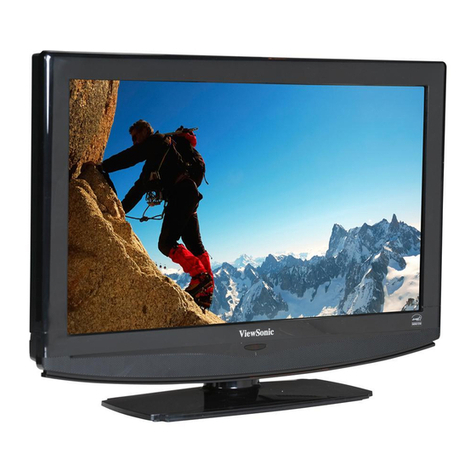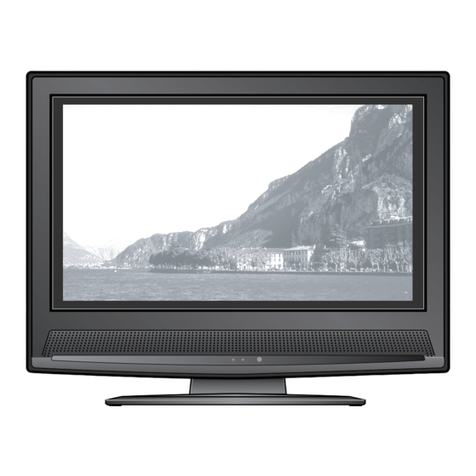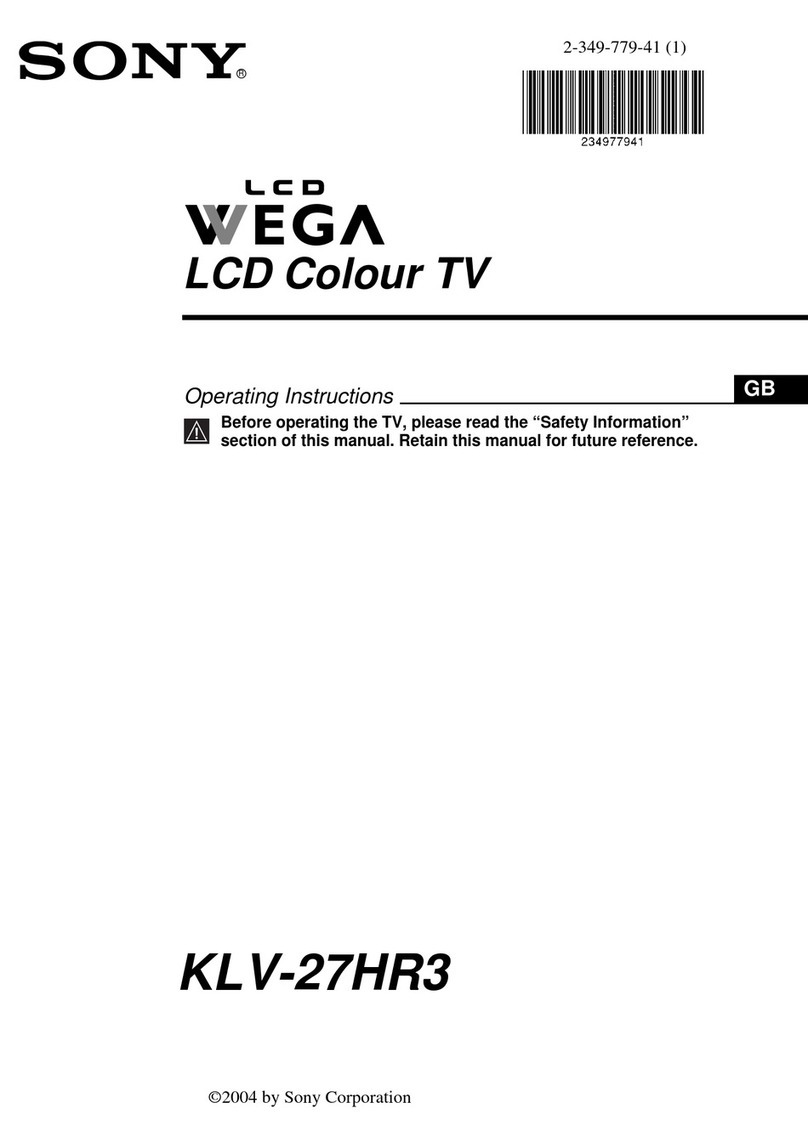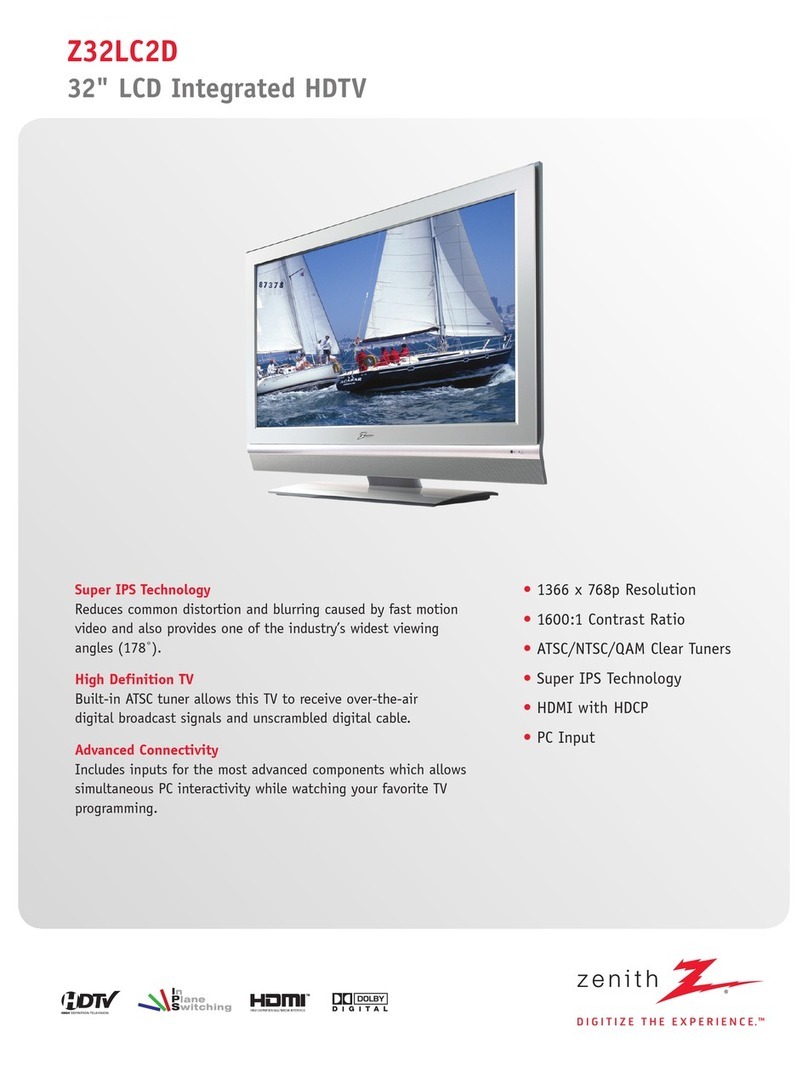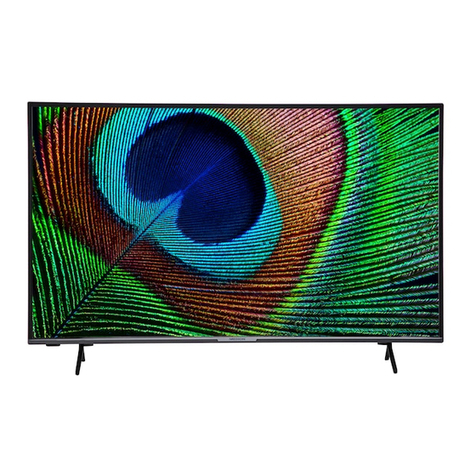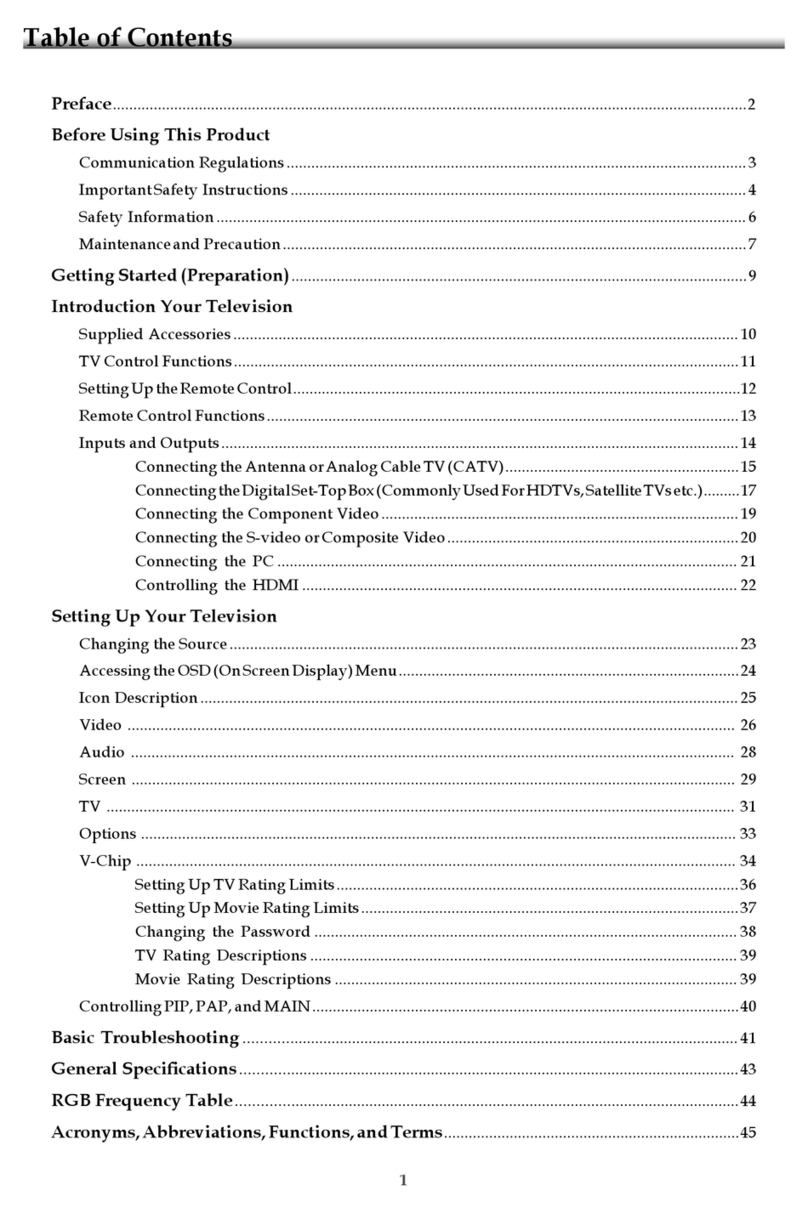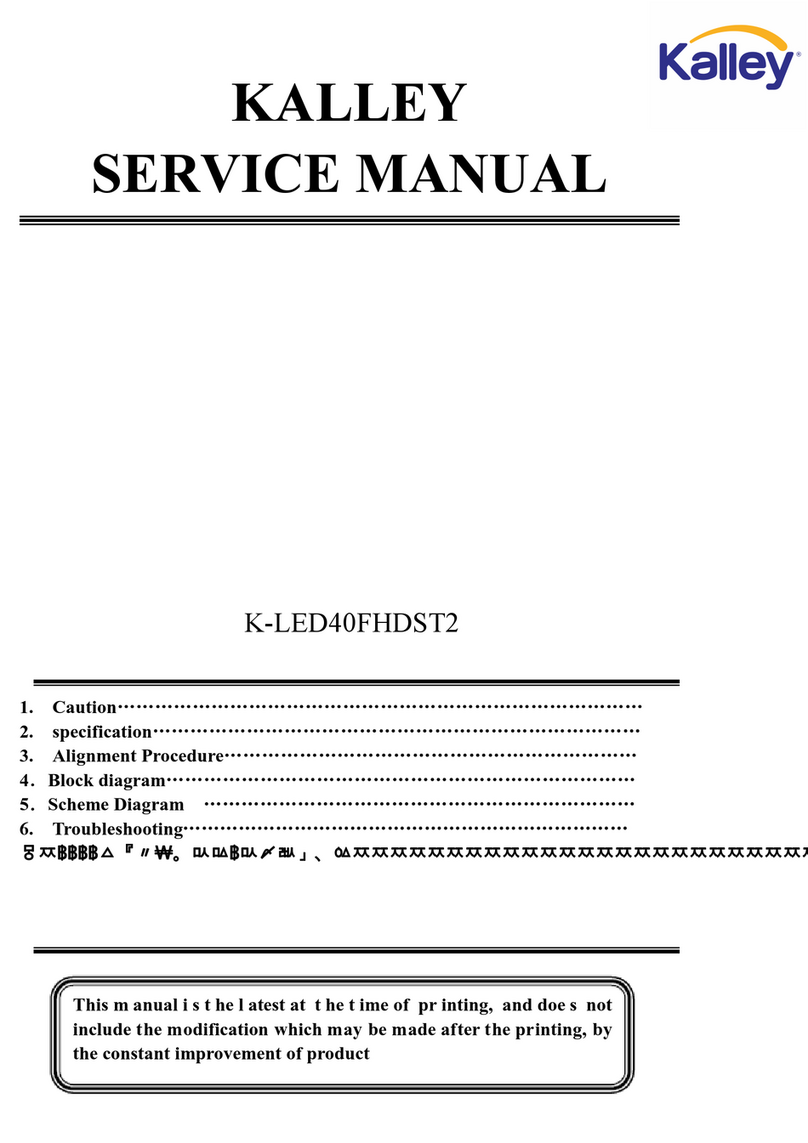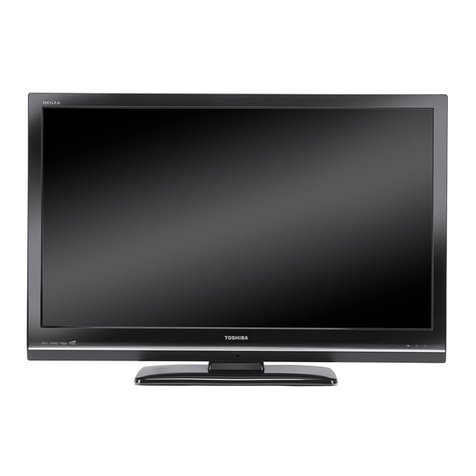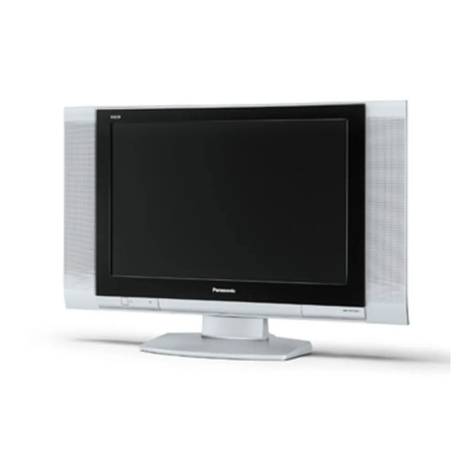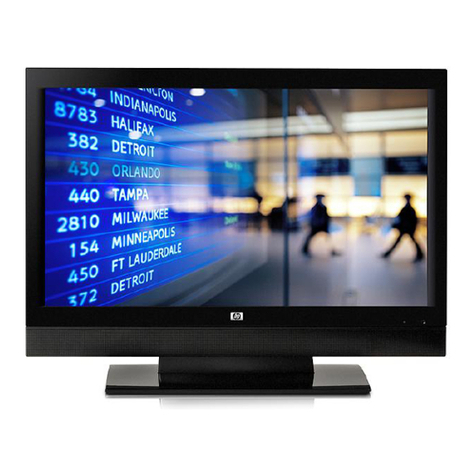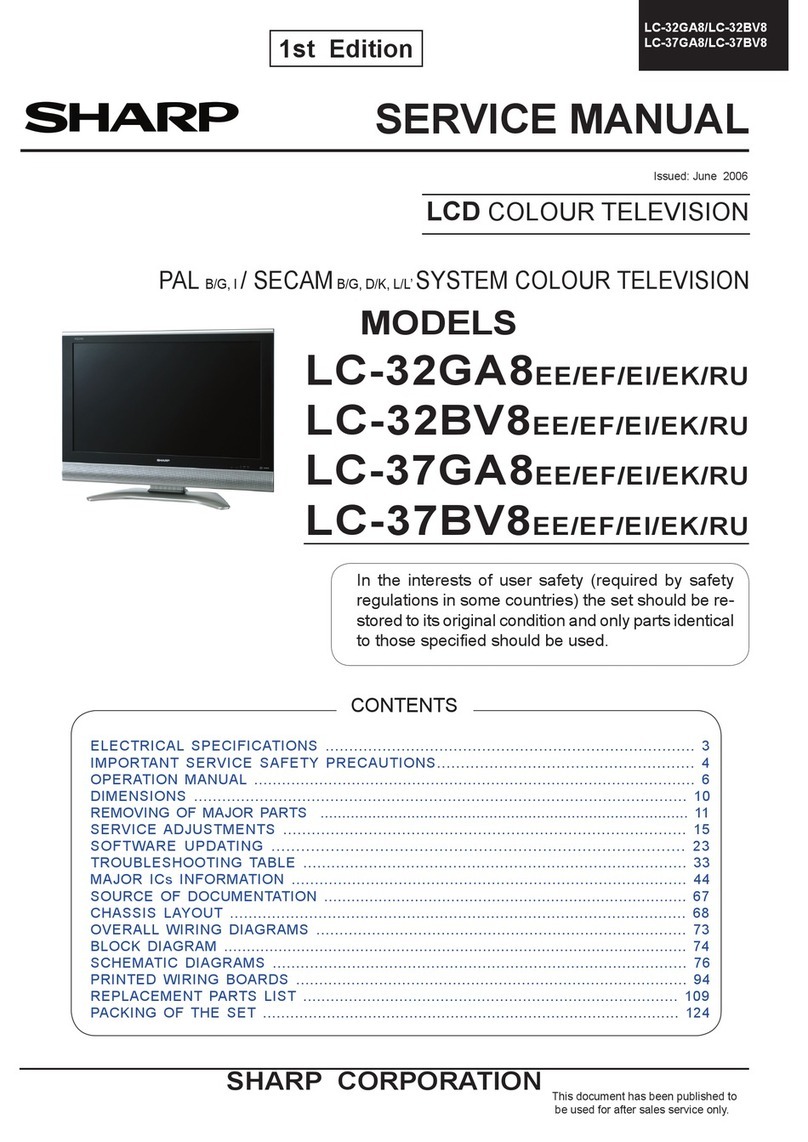SODIFF E&T Co., Ltd. SDD-2301N User manual

Television/Moniter TFT LCD
Model: SDD-2301N
User’s Manual
VOL SELECTMENU CH
Achom_cover_eng 4/6/04 4:39 PM Page 1

2
Warning! Important Safety Instructions
CAUTION
RISK OF ELECTRIC SHOCK
DO NOT OPEN
CAUTION: TO REDUCE THE RISK OF ELECTRIC SHOCK,
DO NOT REMOVE COVER (OR BACK).
NO USER-SERVICEABLE PARTS INSIDE.
REFER SERVICING TO QUALIFIED SERVICE PERSONNEL.
This symbol indicates high voltage is present inside.
It is dangerous to make any kind of contact with any
inside part of this product.
This symbol alerts you that important literature concerning
operation and maintenance has been included with this product.
Note to CATV system installer: This reminder is provided to call CATV system installer’s
attention to Article 820-40 of the National Electrical Code (Section 54 of Canadian
Electrical Code, Part I), that provides guidelines for proper grounding and, in particular,
specifies that the cable ground shall be connected to the grounding system of the building
as close to the point of cable entry as practical.
Caution: FCC/CSA regulations state that any unauthorized changes or modifications to this
equipment may void the user’s authority to operate it.
Caution: To prevent electric shock, match the wide blade of plug to the wide slot, and
fully insert the plug.
Attention: pour eviter les chocs electriques, introduire la lame le plus large de la fiche
dans la borne correspondante de la prise et pousser jusqu’au fond.
Important: One Federal Court has held that unauthorized recording of
copyrighted TV programs is an infringement of U.S. copyright laws.
Certain Canadian programs may also be copyrighted and any unauthorized recording in
whole or in part may be in violation of these rights.
To prevent damage which may result in fire or electric shock
hazard, do not expose this appliance to rain or moisture.
ENG 4/6/04 4:39 PM Page 2

3
•Always be careful when using your TV receiver. To reduce the risk of fire, electrical shock,
and other injuries, keep these safety precautions in mind when installing, using, and
maintaining your machine.
•Read all safety and operating instructions before operating your TV.
•Keep the safety and operating instructions for future reference.
•Heed all warnings on the TV receiver and in the operating instructions.
•Follow all operating and use instructions.
•Unplug the TV receiver from the wall outlet before cleaning. Use a damp cloth; do not use
liquid or aerosol cleaners.
•Never add any attachments and/or equipment without approval of the manufacturer. Such
additions can increase the risk of fire, electric shock, or other personal injury.
•Do not use the TV receiver where contact with or immersion in water is a possibility, such as
near bath tubs, sinks, washing machines, swimming pools, etc.
•Do not place the TV on an unstable cart, stand, tripod, bracket,
or table where it can fall. A falling TV can cause serious injury
to a child or adult, and serious damage to the appliance. Use
only with a cart, stand, tripod, bracket, or table recommended
by the manufacturer or sold with the TV. Follow the
manufacturer’s instructions when mounting the unit, and use a
mounting accessory recommended by the manufacturer. Move
the TV and cart with care. Quick stops, excessive force, and
uneven surfaces can make the unit and cart unsteady and likely
to overturn.
•Provide ventilation for the TV receiver. The unit is designed with slots in the cabinet for
ventilation to protect it from overheating. Do not block these openings with any object, and
do not place the TV receiver on a bed, sofa, rug, or other similar surface. Do not place it
near a radiator or heat register. If you place the TV receiver on a rack or bookcase, ensure
that there is adequate ventilation and that you’ve followed the manufacturer’s instructions for
mounting.
•Operate your TV receiver only from the type of power source indicated on the marking label.
If you are not sure of the type of power supplied to your home, consult your appliance dealer
or local power company.
•Use only a grounded or polarized outlet. For your safety, this TV is equipped with a polarized
alternating current line plug having one blade wider than the other. This plug will fit into the
power outlet only one way. If you are unable to insert the plug fully into the outlet, try
reversing the plug. If the plug still does not fit, contact your electrician to replace your outlet.
•Protect the power cord. Power supply cords should be routed so that they won’t be walked
on or pinched by objects placed on or against them. Pay particular attention to cords at
plugs, convenience receptacles, and the point where they exit from the unit.
Important Safety Information
ENG 4/6/04 4:39 PM Page 3

4
•Unplug the TV from the wall outlet and disconnect the antenna or cable system during a
lightning storm or when left unattended and unused for long periods of time. This will
prevent damage to the unit due to lightning and power-line surges.
•Avoid overhead power lines. An outside antenna system should not be placed in the vicinity
of overhead power lines or other electric light or power circuits or where it can fall into such
power lines or circuits. When installing an outside antenna system, be extremely careful to
keep from touching the power lines or circuits. Contact with such lines can be fatal.
•Do not overload the wall outlet or extension cords. Overloading can result in fire or electric
shock.
•Do not insert anything through the openings in the unit, where they can touch dangerous
voltage points or damage parts. Never spill liquid of any kind on the TV.
•Ground outdoor antennas. If an outside antenna or cable system
is connected to the TV, be sure the antenna or cable system is
grounded so as to provide some protection against voltage
surges and built-up static charges. Section 810 of the National
Electrical Code, ANSI/NFPA No.70-1984, provides information
about proper grounding of the mast and supporting structure,
grounding of the lead-in wire to an antenna discharge unit, size
of grounding conductors, location of antenna discharge unit,
connection to grounding electrodes, and requirements for the
grounding electrode.
•Do not attempt to service the TV yourself. Refer all servicing to qualified service personnel.
Unplug the unit from the wall outlet and refer servicing to qualified service personnel under
the following conditions:
- when the power-supply cord or plug is damaged
- if liquid has been spilled on the unit or if objects have fallen into the unit
- if the TV has been exposed to rain or water
- if the TV does not operate normally by following the operating instructions
- if the TV has been dropped or the cabinet has been damaged
- when the TV exhibits a distinct change in performance
•If you make adjustments yourself, adjust only those controls that are covered by the operating
instructions. Adjusting other controls may result in damage and will often require extensive
work by a qualified technician to restore the TV to normal.
•When replacement parts are required, be sure the service technician uses replacement parts
specified by the manufacturer or those that have the same characteristics as the original part.
Unauthorized substitutions may result in additional damage to the unit.
•Upon completion of any service or repairs to this TV, ask the service technician to
perform safety checks to determine that the TV is in a safe operating condition.
ANTENNA
LEAD IN WIRE
ANTENNA
DISCHARGE UNIT
(NEC SECTION 810-20)
GROUNDING
CONDUCTORS
(NEC SECTION 810-21)
GROUND CLAMPS
POWER SERVICE GROUNDING
ELECTRODE SYSTEM
(NEC ART 250, PART H)
GROUND CLAMP
ELECTRIC
SERVICE
EQUIPMENT
NEC — NATIONAL ELECTRICAL CODE
EXAMPLE OF
ANTENNA GROUNDING
This device complies with part 15 of the FCC Rules.
Operation is subject to the following two conditions:
(1) This device may not cause harmful interference, and
(2) This device must accept any interference that may cause undesired operation.
This television receiver provides display of television closed captioning in accordance
with §15.119 of the FCC rules.
ENG 4/6/04 4:39 PM Page 4

5
User Instructions
The Federal Communications Commission
Radio Frequency Interference Statement
includes the following warning:
NOTE: This equipment has been tested and
found to comply with the limits for a Class B
digital device, pursuant to Part 15 of the FCC
Rules. These limits are designed to provide
reasonable protection against harmful
interference in a residential installation. This
equipment generates, uses, and can radiate
radio frequency energy and, if not installed
and used in accordance with the instructions,
may cause harmful interference to radio
communications. However, there is no
guarantee that interference will not occur in a
particular installation .
If this equipment does cause harmful
interference to radio or television receptions,
which can be determined by turning the
equipment off and on, the user is encouraged
to try to correct the interference by one
or more of the following measures:
• Reorient or relocate the receiving antenna.
• Increase the separation between the
equipment and receiver.
• Connect the equipment into an outlet on a
circuit different from that to which the
receiver is connected.
• Consult the dealer or an experienced
radio/TV technician for help.
User Information
Changes or modifications not expressly
approved by the party responsible for
compliance could void the user’s authority to
operate the equipment. If necessary, consult
your dealer or an experienced
radio/television technician for additional
suggestions.
You may find the booklet called How to
Identify and Resolve Radio/TV Interference
Problems helpful. This booklet was prepared
by the Federal Communications Commission.
It is available from the U.S. Government
Printing Office, Washington, DC 20402,
Stock Number 004-000-00345-4 .
Warning
User must use shielded signal interface
cables to maintain FCC compliance for the
product. Declaration of conformity for
products marked with FCC Logo. This device
complies with Part 15 of the FCC Rules.
Operation is subject to the following two
conditions: (1) this device may not cause
harmful interference, and (2) this device must
accept any interference received, including
interference that may cause undesired
operation.
Provided with this monitor is a detachable
power supply cord with IEC320 style
terminations. It may be suitable for
connection to any UL Listed personal
computer with similar configuration. Before
making the connection, make sure the
voltage rating of the computer convenience
outlet is the same as the monitor and that the
ampere rating of the computer convenience
outlet is equal to or exceeds the monitor
voltage rating.
For 120 Volt applications, use only UL Listed
detachable power cord with NEMA
configuration 5-15P type (parallel blades)
plug cap. For 240 Volt applications use only
UL Listed Detachable power supply cord
with NEMA configuration 6015P type
(tandem blades) plug cap.
IC Compliance Notice
This Class B digital apparatus meets all
requirements of the Canadian Interference-
Causing Equipment Regulations of ICES-003.
Notice de Conformité IC
Cet appareil numérique de classe B respecte
toutes les exigences du Règlement ICES-003
sur les équipements produisant des
interférences au Canada.
FCC Information
ENG 4/6/04 4:39 PM Page 5

6
Contents
Warning! Important Safety Instructions ......................................................................................................2
Important Safety Information............................................................................................................3
FCC Information ..............................................................................................................................5
Parts Description ........................................................................................................................................7
Front panel.......................................................................................................................................7
Rear panel jacks...............................................................................................................................7
Remote Control Unit .......................................................................................................................8
Inserting the batteries in the remote control .....................................................................................8
Connecting ..................................................................................................................................................9
Connecting the aerial or cable television network............................................................................9
Connecting to the VCR or other external devices.............................................................................9
Connecting to the DVD or Digital TV Set-top Box ...........................................................................9
Connecting to the DVI input ..........................................................................................................10
Connecting a PC ............................................................................................................................10
Watching a TV ..........................................................................................................................................11
Turning the TV On and OFF ..........................................................................................................11
Viewing the Menus ........................................................................................................................11
Using the Volume Buttons ..............................................................................................................11
Using the MUTE Button..................................................................................................................11
Memorizing the Channels..........................................................................................................................12
Selecting the Video Signal-source ..................................................................................................12
Storing Channels in Memory (Automatic Method)..........................................................................12
Adding and Removing Channels (Manual Method) ........................................................................13
Picture Control ..........................................................................................................................................14
Changing the Picture Standard ......................................................................................................14
Adjusting the Picture Settings ........................................................................................................14
Adjusting the Picture Position (D-Sub or DVI Mode) ....................................................................15
Adjusting the Color Temperature ..................................................................................................15
Selecting the Picture Size ..............................................................................................................16
Viewing the Picture In Picture (PIP)................................................................................................17
Sound Control............................................................................................................................................18
Changing the Sound Standard ........................................................................................................18
Adjusting the Sound Settings ..........................................................................................................18
Adjusting the Volume Automatically ............................................................................................19
Time Setting ..............................................................................................................................................20
Setting and Displaying the Current Time........................................................................................20
Switching the Television On and Off Automatically ......................................................................21
Special Features ........................................................................................................................................22
Fine Tuning Channels ....................................................................................................................22
LNA (Low Noise Amplifier) ............................................................................................................22
Setting the OSD Timeout ..............................................................................................................23
Adjusting the Menu Background ....................................................................................................23
Viewing Closed Captions................................................................................................................24
Using the content blocking ............................................................................................................25
Setting up your Personal ID Number (PIN) ....................................................................................25
How to Set up Restrictions using the “TV Blocking” ......................................................................26
How to Set up Restrictions using the Blocking Movie(MPAA): G, PG, PG-13, R, NC-17, X............28
PC Control ................................................................................................................................................29
How to Set up Your PC Software (Windows only) ..........................................................................29
Display Modes ..............................................................................................................................30
Pin Assignments ............................................................................................................................31
Troubleshooting ........................................................................................................................................32
Specification ..............................................................................................................................................33
ENG 4/6/04 4:39 PM Page 6

7
Parts Description
Rear panel jacks
Rear panel
ŒREMOTE CONTROL SENSOR
´MENU
Display the main on-screen menu.
Exit from sub-menu.
ˇ▼ CHANNEL ▲
Press CH ▼or CH ▲to change channels.
Also used to highlight selections on the
on-screen menus.
¨POWER
Switches the set off (standby mode) and on.
ˆœœVOLUME √√
Press to increase or decrease the volume.
Also used to increase or reduce the value of a
menu option.
ØSELECT
Select input signal or select submenu of the
on-screen menu.
∏LAMP
Power ON/OFF Indicator.
ŒANT RF-IN
´POWER JACK
ˇPC VIDEO INPUT
¨DVI INPUT
Connect to the digital video output jack for device
with DVI output.
ˆPC AUDIO INPUT
Connects to the sound-output port of a personal
computer.
ØS-VIDEO IN
Video input for external devices with an S-Video
output, such as a camcorder or VCR.
∏ VIDEO INPUT
Video input for external devices, such as a
camcorder or VCR.
”AUDIO INPUTS (VIDEO,S-VHS)
Audio signals from VCR or similar device.
’AUDIO INPUTS (DTV, DVD)
Audio signals from Digital TV Set-top Box or DVD
player when using the component input jacks.
˝Component VIDEO INPUT(DTV)
Component video signal from a Digital TV Set-top
Box.
ÔComponent VIDEO INPUT (DVD)
Component video signal from a DVD.
HEAD PHONE JACK
Connect a set of external headphones to this jack
for private listening.
Front panel
VOL SELECTMENU CH
VOL SELECTMENU CH
ŒŒ´´¨¨ØØ
∏
ˇˇˆˆ
D-SUB DVI S-VHS VIDEO
DTV(480p/720p/1080i)
AUDIO
L
R
PC AUDIO
DCANT
HEAD PHONE
DVD(480i)
YPr
Pb
YPr
Pb
ŒŒ´´ˇˇ¨¨ˆˆØØ∏∏””’’ÔÔ
˝˝
ENG 4/6/04 4:39 PM Page 7

S.STD P.STD SURROUND
POWER
12 3
45 6
78 9
0
PRE.CH
PIP SRC PIP SIZE PIP POS
ENTER
PBP
PIP
EXIT
MENU
AUTO
SLEEP MTS FREEZE
MUTE
SRC
8
Parts Description
Remote Control Unit
ŒPOWER: Turns the TV On
and Off.
´MUTE: Press to temporarily
cut off the sound.
ˇSRC: Press to display all of
the available video sources
(i.e., TV, S-Video, Video,
DVD, D-sub, DVI, HDTV)
¨SLEEP: Selects a preset time
interval for automatic shut
off.
ˆFREEZE: Press to pause the
current screen. Press again
to cancel.
ØMTS: Press to choose
stereo, dual or mono.
∏NUMBER (0 ~ 9) : Selects
the channel directly.
”PRE.CH: Moves to the
previous channel.
’AUTO: Resets
automatically the screen
quality and position in PC
(D-sub) mode.
˝▼▲: Change channels.
Also used to highlight
selection on the on-screen
menus.
Ôœœ√√: Press to increase or
decrease the volume. Also
used to make selection on
the on-screen menus.
ENTER: Confirms a
selection.
ÒMENU: Displays on-screen
menu.
ÚEXIT: Press to exit the
menu.
ÆPIP: Activates picture in
picture.
ıPBP: Selects double picture
windows in PIP mode.
˜PIP SRC: Selects an
external source in PIP
mode.
¯PIP SIZE: Changes the sub-
picture size in PIP mode.
˘PIP POS : Changes the sub
picture location in PIP
mode.
Inserting the batteries in the remote control
You can use your remote control within a distance of 7~10m and an angle of 30 degrees from the left and right
sides of the remote control receptor of your monitor.
You must insert or replace the batteries in the remote control when you:
•Purchase the set.
•Find that the remote control is no longer operating correctly.
1Remove the cover of the
remote control by pressing
the symbol and pulling the
cover space in the
direction of the arrow.
2Insert 2 batteries (AAA size),
taking care to respect the
polarities.
3Replace the cover
by pushing it in the
direction of the arrow.
ENG 4/6/04 4:39 PM Page 8

9
Connecting
To view television channels correctly, a signal must be received by the set
from one of following sources :
•An outdoor aerial
•An indoor aerial (Not recommendable)
•Acable television network
1In the first three cases, connect the aerial or network input cable to
the 75 ohm coaxial socket on the bottom of the television.
2Press the SRC button on the remote control.
Connecting the aerial or cable television network
AIR
Cable Television Network
Connecting to the VCR or other external devices
1Connect video and audio cable according to the shape and color of the video / audio cable.
• When an external devices is in MONO, the audio connection cable can be connected to either the left
and S.MODE should be set FM MONO.
2For optimal visual image, use S-VHS connector instead of video (yellow) connector.
Connecting to the DVD or Digital TV Set-top Box
1Connect component video and audio cable according to the shape and color of the component video /
audio cable.
• When an external devices is in MONO, the audio connection cable can be connected to either the
left and S.MODE should be set FM MONO.
(Note: For the explanation of component video, see your DVD player or Digital TV Set-top Box owner’s
manual.)
ENG 4/6/04 4:39 PM Page 9

10
Connecting
Connecting a PC
1Turn off your computer and monitor.
2Connect a PC D-sub cable between your PC and PC-VIDEO-IN of the monitor.
3Connect a PC audio cable between the sound output jack of the sound card on a PC and the
PC-AUDIO-IN of the monitor.
4Connect a DC power unit cable to the power jack on the rear of your monitor. And connect a power
cable to the DC power unit before connecting to a power outlet.
5Power on the computer before turning on the monitor.
D-SUB DVI S-VHS VIDEO
DTV(480p/720p/1080i)
AUDIO
L
R
PC AUDIO
DCANT HEAD PHONE
DVD(480i)
YPr
Pb
YPr
Pb
PC
DVD
VCR
CAMCORDER
HEAD PHONE
Digital TV Set-top Box
Digital TV Set-top Box
L-AUDIO-R
D-SUB DVI S-VHS VIDEO
DTV(480p/720p/1080i)
AUDIO
L
R
PC AUDIO
DCANT HEAD PHONE
DVD(480i)
YPr
Pb
YPr
Pb
VIDEO
S-VIDEO
PC
PC
or
or
Connecting to the DVI input
Connect to the digial video output jack for device with DVI output.
ENG 4/6/04 4:39 PM Page 10

11
Watching a TV
1Power on your television by pressing the POWER button on the main
or the remote control. You can also switch on by pressing the
CH ▼/▲.
•Power On : GREEN
•Power Off : RED
POWER
12 3
45 6
78 9
0
PRE.CH AUTO
SLEEP MTS FREEZE
MUTE
SRC
Turning the TV On and OFF
ENTER
PBP
PIP
EXIT
MENU
Viewing the Menus
1With the power on, press the MENU button.
The main menu appears on the screen.
You can also use the MENU, CH ▲ or ▼, and VOL œor √buttons
on the front panel of the TV to make selections.
2Press the œor √button to move items in the menu.
Press the ▲ or ▼and ENTER buttons to display, change, or use the
selected items. Press the œor √button to enter items in the menu.
Result
Result: On screen menus disappear from the screen automatically
after a few seconds.
50
50
50
50
50
PICTURE
User
5500K 6500K 7500K 9300K user
Down to setting for current Picture Window
Picture Mode
Brightness
Contrast
Sharpness
Color
Tint
Color temp
50
Using the Volume Buttons
Press the œor √button to increase or decrease the volume.
Using the MUTE Button
At any time, you can temporarily cut off the sound using the MUTE button.
1Press the MUTE button and the sound cuts off.
2To turn mute off, press the MUTE button again, or simply press the
œor √button. You must first do the “Storing Channels in Memory”
procedure (See page 14) before you can use the ▲ or▼button.
Volume
Volume up/down or right/left to adjust Menu to return
ENG 4/6/04 4:39 PM Page 11

12
Memorizing the Channels
1Press the MENU button.
The main menu is displayed.
2Press the œor √button to select TUNER.
The options available in the TUNER group are displayed.
3Press the ▼or ENTER button to select the options in the TUNER
group.
4Press the ▲ or ▼button to select Air/CATV.
5Press the œor √button to select your Signal Source (Air and Cable).
6Press the MENU button to exit.
Your TV can memorize and store all of the available channels for both “Air (antenna)”
and Cable channels.
Selecting the Video Signal-source
Before your television can begin memorizing the available channels, you must specify the type of signal source that is
connected to the TV (i.e., an antenna or a cable system).
50
15 32 18
2563418
2563418
2563418
TUNER
Air
Off
<Select> to enable
Down to change tuner input and settings
Edit channels
Fine tune
Air/CATV
Auto Program
LNA
50
15 32 18
2563418
2563418
2563418
TUNER
Air
Off
<Select> to enable
Right/Left to change source
Edit channels
Fine tune
Air/CATV
Auto Program
LNA
1First, select the correct antenna (Air and Cable).
Press the MENU button.
The main menu is displayed.
2Press the œor √button to select TUNER, then
press the ▼or ENTER button.
3Press the ▲ or ▼button to select Auto Program, then
press the œ / √/ ENTER button to start the channel search.
4The TV will begin memorizing all of the available channels.
After all the available channels are stored, the Auto program menu
reappears.
Note
Note:
•
To stop the search before it has finished, press the MENU
button.
•
The TV automatically cycles through all of the available
channels and stores them in memory. This takes about one to
two minutes.
Storing Channels in Memory (Automatic Method)
50
15 32 18
2563418
2563418
2563418
TUNER
Air
Off
<Select> to enable
Select to activate autoset
Edit channels
Fine tune
Air/CATV
Auto Program
LNA
Channel searching
Please wait or
press menu to cancel
ENG 4/6/04 4:39 PM Page 12

13
1Press the MENU button.
The main menu is displayed.
2Press the œor √button to select TUNER.
The options available in the TUNER group are displayed.
3Press the ▼or ENTER button to select the options in the TUNER
group.
4Press the ▲ or ▼button to select Edit channels.
5Press the œor √button.
The ADD/REMOVE channel menu will be displayed at the bottom of
the screen.
6Press the ▲ or ▼button to select the channel you want to add or
remove. To Add or remove the channel, press the œor √button,
then press the ENTER button.
7Press the MENU button to exit.
Adding and Removing Channels (Manual Method)
50
2563418
2563418
15 32 18
2563418
TUNER
Air
Off
<Select> to enable
Select to edit channel memory
Edit channels
Fine tune
Air/CATV
Auto Program
LNA
Channel Up/Down to change channel
Left/Right to Add/Remove channel
Menu to return
ADD REMOVE
ENG 4/6/04 4:39 PM Page 13

14
Picture Control
1Press the MENU button.
The main menu is displayed.
2Press the œor √button to select PICTURE.
The options available in the PICTURE group are displayed.
3Press the ▼or ENTER button to select the options in the PICTURE
group.
4Select the option by pressing the œor √button.
The following modes are available depending on the input
source.
•Dynamic - Standard - Movie – User
5Press the œor √button to reach the required setting.
6Press the MENU button to exit.
Changing the Picture Standard
You can select the type of picture which best corresponds to your viewing requirements.
50
50
50
50
50
PICTURE
Dynamic
5500K 6500K 7500K 9300K user
Right/Left to change Picture mode
Picture Mode
Brightness
Contrast
Sharpness
Color
Tint
Color temp
1Press the MENU button.
The main menu is displayed.
2Press the œor √button to select PICTURE.
The options available in the PICTURE group are displayed.
3Press the ▼or ENTER button to select the options in the PICTURE
group.
4Select the User by pressing the œor √button.
The User options are activated.
•Brightness, Contrast, Sharpness, Color, Tint.
•Brightness, Contrast, Phase, Frequency. (D-sub or DVI mode)
5Press the œor √button to reach the required setting.
6Press the MENU button to exit.
Note
Note:
•
When the User Picture Mode is set, the settings values may vary
depending on the input source.
Adjusting the Picture Settings
Your television has several settings which allow you to control picture quality.
50
50
50
50
50
PICTURE
User
5500K 6500K 7500K 9300K user
Right/Left to change Picture mode
Picture Mode
Brightness
Contrast
Sharpness
Color
Tint
Color temp
50
6500K
50
50
50
50
PICTURE
D-sub Mode
5500K 6500K 7500K 9300K user
Right/Left to adjust frequency
Contrast
Color temp
User color temp
H Position
V Position
Phase
Frequency
ENG 4/6/04 4:39 PM Page 14

15
Picture Control
Adjusting the Color Temperature
Your television has several settings which allow you to control picture quality.
50
6500K
50
50
50
50
PICTURE
D-sub Modde
5500K 6500K 7500K 9300K user
Right/Left to adjust frequency
Contrast
Color temp
User color temp
H Position
V Position
Phase
Frequency
Adjusting the Picture Position (D-sub or DVI Mode)
Preset to the D-sub or DVI mode by using the SRC button.
1Press the MENU button.
The main menu is displayed.
2Press the œor √button to select PICTURE.
The options available in the PICTURE group are displayed.
3Press the ▼or ENTER button to select the options in the PICTURE
group.
4Press the ▲ or▼button to select the option (H Position, VPosition)
to be adjusted.
5Press the œor √button to reach the required setting.
6Press the MENU button to exit.
1Press the MENU button.
The main menu is displayed.
2Press the œor √button to select PICTURE.
The options available in the PICTURE group are displayed.
3Press the ▼or ENTER button to select the options in the PICTURE
group.
4Select the Color temp by pressing ▲ or ▼button.
5Select the option by pressing the œor √button.
The following modes are available :
5500K(Warm) – 6500K – 7500K – 9300K(Cool) - user
6Press the MENU button to exit.
Customizing the Color Temperature
•When you set the color temperature option to user in step 5 above,
the User color temp is activated.
•Adjust the color temperature you want by pressing œ/ √or ENTER
button.
Note
Note:
•
The color temperature is available from 5000K to 9300K and the
interval is 100K.
50
50
50
50
50
PICTURE
User
5500K 6500K 7500K 9300K user
Right/Left to set color temperature
Picture Mode
Brightness
Contrast
Sharpness
Color
Tint
Color temp
50
50
50
50
50
6600K
PICTURE
User
5500K 6500K 7500K 9300K user
Right/Left to set color temperature
Picture Mode
Brightness
Contrast
Sharpness
Color
Tint
Color temp
ENG 4/6/04 4:39 PM Page 15

16
WINDOW
Full
Fill all
Off
60 sec
Right/Left to change image size
Layout
Image size
OSD Timeout
Menu background
Close caption mode
Close caption
Selecting the Picture Size
You can select the picture size which best corresponds to your viewing requirements.
Picture Control
1Press the MENU button.
The main menu is displayed.
2Press the œor √button to select WINDOW.
The options available in the WINDOW group are displayed.
3Press the ▼or ENTER button to select the options in the WINDOW
group.
4Press the ▲ or ▼button to select Image size.
5Press the œor √button to change the setting.
The picture size are displayed in the following order.
Fill all – Normal – Panorama – Zoom
Fill all: Sets the picture to 16:9 wide mode.
Normal:
Displays the current picture on the 4:3 aspect ratio format
screen.
Panorama : Use this mode for the wide aspect ratio of a panoramic
picture.
Zoom: Magnify the size of the picture vertically on screen.
6Press the MENU button to exit.
XDS
Opaque
ENG 4/6/04 4:39 PM Page 16

17
Picture Control
Viewing the Picture In Picture (PIP)
You can display a sub picture within the main picture of TV program or external A/V devices. In this way you can
watch TV program or monitor the video input from any connected devices while watching TV or other video input.
1Press the MENU button.
The main menu is displayed.
2Press the œor √button to select WINDOW.
The options available in the WINDOW group are displayed.
3Press the ▼or ENTER button to select the options in the WINDOW
group.
4Press the ▲ or ▼button to select Layout.
5Press the œor √button to change the Image size option.
The options are displayed in the following order :
Full PIP PBP
Note
Note: If the sub picture has no signal and the main picture is output
from a external signal, the sub picture will be viewed in black color.
6Press the MENU button to exit.
Easy functions of remote control
Buttons Feature
PIP PIP On/Off
PBP Double picture selection
PIP SRC Sub picture source selection
PIP SIZE Sub picture size selection
PIP POS Sub picture location selection
The Table of PIP Settings O : PIP operates
X :
PIP doesn’t operate
WINDOW
Right/Left to change window layout
Layout
Image size
OSD Timeout
Menu background
Close caption mode
Close caption
TV S-Video Video DVD D-sub DVI HDTV
TV
S-Video
Video
DVD
D-sub
DVI
HDTV
X
Sub Main
Full
Fill all
Off
60 sec
XDS
Opaque
X
X
X
X
X
X
X
X
X
X
X
X
X
X
X
X
X
X
X
X
X
X
X
X
ENG 4/6/04 4:39 PM Page 17

18
Sound Control
Changing the Sound Standard
You can select the type of special sound effect to be used when watching a given broadcast.
1Press the MENU button.
The main menu is displayed.
2Press the œor √button to select AUDIO.
The options available in the AUDIO group are displayed.
3Press the ▼or ENTER button to select the options in the AUDIO
group.
4Press the œor √button to select the options.
The sound effects are displayed in the following order.
Music - Normal – News – User
5Press the MENU button to exit.
50
50
50
50
AUDIO
Music
Off
Use right/left keys to change audio mode
Audio Mode
Bass
Treble
Balance
Auto Volume
50
50
50
50
AUDIO
User
Off
Use right/left keys to change audio mode
Audio Mode
Bass
Treble
Balance
Auto Volume
Adjusting the Sound Settings
The sound settings can be adjusted to suit your personal preferences.
1Press the MENU button.
The main menu is displayed.
2Press the œor √button to select AUDIO.
The options available in the AUDIO group are displayed.
3Press the ▼or ENTER button to select the options in the AUDIO
group.
4Press the ▲ or ▼button to select User.
The User menu is activated.
5Press the ▲ or ▼button to select the option (Bass, Treble, Balance).
6Press the œor √button to reach the required setting.
7Press the MENU button to exit.
ENG 4/6/04 4:39 PM Page 18

19
Adjusting the Volume Automatically
Each broadcasting station has its own signal conditions, and so it is not easy for you to adjust the volume every
time the channel is changed. This feature lets you automatically adjust the volume of the desired channel by
lowering the sound output when the modulation signal is high or by raising the sound output when the modulation
signal is low.
1Press the MENU button.
The main menu is displayed.
2Press the œor √button to select AUDIO.
The options available in the AUDIO group are displayed.
3Press the ▼or ENTER button to select the options in the AUDIO
group.
4Press the ▲ or ▼button to select Auto Volume.
5Press the œor √button to select Off or On.
6Press the MENU button to exit.
50
50
50
50
AUDIO
Music
Off
Right/Left to change audio auto volume
Audio Mode
Bass
Treble
Balance
Auto Volume
Sound Control
ENG 4/6/04 4:39 PM Page 19

20
Time Setting
1Press the MENU button.
The main menu is displayed.
2Press the œor √button to select TIMES.
The options available in the TIMES group are displayed.
3Press the ▼or ENTER button to select the options in the TIMES
group.
4Press the ENTER button to set the current time.
5Press the ▲ /▼or ENTER button to select AM/PM.
6Press the œor √button to move to the Hour or Minute in.
Set the Hour or Minute by pressing the ▲ /▼ or ENTER button.
7Press the MENU button to exit.
TIMES
Right to enter the Time Clock Setting
Time
Once/Every/Day
On Time
Off Time
Setting and Displaying the Current Time
You can set the television’s clock.
AM 12 : 00
ENG 4/6/04 4:39 PM Page 20
Table of contents

